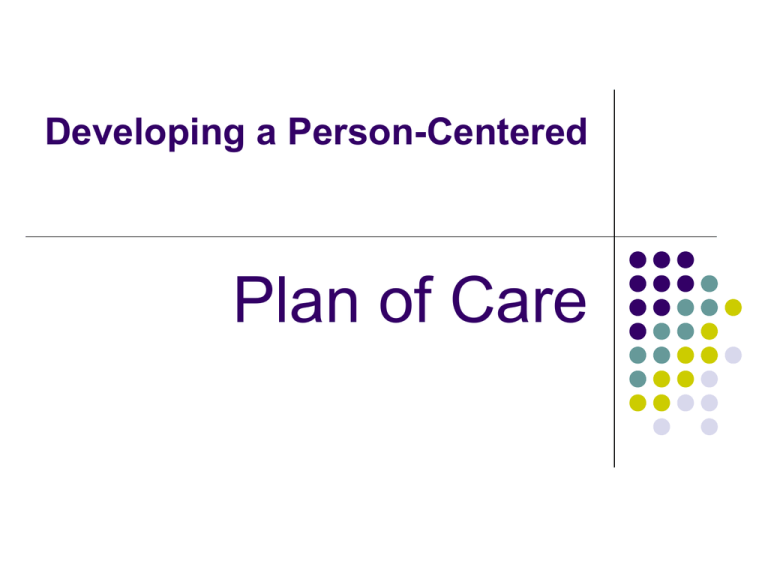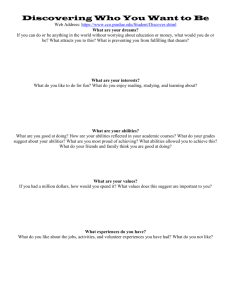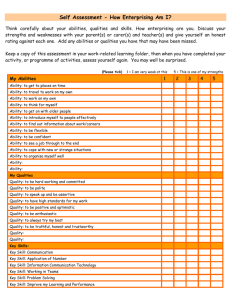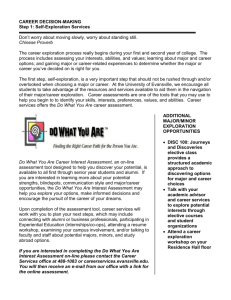Developing a Person-Centered Recovery
advertisement

Developing a Person-Centered Plan of Care Planning Care Planning care is the most important task, the foundation for all that is to come in treatment. There is no place for….. Assuming to know what is best for the client Not sharing the assessment/diagnosis results Not communicating and making shared decisions Dismissing the individual’s preferences and goals Fostering dependency rather than selfreliance and recovery Developing the POC….. Must be a learning experience for the client and the clinician Acts as the basic foundation of an effective helping relationship. Clinicians have the responsibility to fully understand the client and family, their strengths, abilities and past successes, along with their hopes, dreams, needs and problems in seeking help. This prepares us to help create a plan consistent with the expressed values, culture and wishes of those receiving services. Strengths, Needs, Abilities & Preferences (SNAPS) These are the foundation of the treatment goals and objectives listed in the plan of care. Strengths & Abilities Refer to characteristics of the clients, or elements in the clients’ life, used in the past or present to help them cope with stressful situations. As used in treatment planning help promote clients’ success in reaching his/her goals. Examples of Strengths Principles Religious beliefs Supportive friends Supportive family** Being able to work Being able to care for others despite own problems Hope **If the client has a supportive family member, then that member can be brought into the treatment process, with client’s permission, and ask that they help client with access to medication and transportation. Example of Abilities Listens to adults Attends to activities of daily living (ADLs) Skills in reading, writing Asks for help Capacity to learn Learns from errors Talents Saves money Able to take care of self Follows instructions Recognizes side effects of medications Example If the client has the ability to type, this could be used in treatment as a way of asking client to research information in the internet to help him/her manage their symptoms. In formulating objectives, ask client about how their _________ (particular strengths and/or abilities) can help them achieve these. For example, if a client can save money and s/he wants a car, how can this ability be used to help client reach her/her goal? This can then be included as a therapeutic objective, e.g. “client will budget and save $5.00 a month toward driving classes”. Needs- Refer to the client’s problems and symptoms and serve as the basis for goal formulation. Examples – Learn about my illness To remain in school A job, and/or to know what kind of job I can do Companionship Supervision of daily living Services from other agencies To be monitored closely at home Preferences – refers to what the client wants in terms of the practical aspects of treatment. The following questions may help the client to state their preferences: If we can accommodate, would you prefer a male or female counselor? A counselor familiar with your particular culture, spiritual beliefs and/or race? If we can accommodate, would you prefer having your appointments first in the morning, over lunchtime, before 4 p.m. or after 5 p.m.? Examples of preferences: Appointment times Specific programs A therapist of same or opposite sex Plan of Care (POC) A road map The goal of services is the destination Consistent with the client’s vision of recovery Goals Goals should reflect the client’s and family’s clearest articulation of the destination – the primary reason for seeking help and receiving services. Goals should be broad general statements that express the individual’s and family’s desire for change and improvement in their lives. It is often appropriate to have only one goal that captures the essence of the individual’s and family’s vision of their recovery and service needs. Having too many goals or goals that are too specific can seriously undermine the planning process. Developing Goals Goals are developed from information gained during the assessment and the understanding derived from the Interpretive Summary. The assessment process helps to identify each individual’s and family’s unique attributes, including needs, problems, strengths, resources, barriers and priorities in reaching the goals. In a person-centered approach, the clinician’s responsibilities are – 1. To help the individual and family identify and express those issues and needs and 2. To help frame the resolution of those needs as goals to be included on the POC. Assist the client to elicit relevant treatment goals. REMEMBER: If the client is unable to state his/her own goals, then a family member or the clinician can state the initial treatment goals, until the client is able to actively participate in the development of his/her treatment plan. Some questions to assist the client in formulating his/her goals: If you no longer had _____ (symptoms/condition) what would you do? If you were not _____ (symptoms/condition) how would your life be different? Is there anything missing from your life as result of ____ (symptoms, problems) that you would like to have? Before you started to have ______ (symptoms/condition), what did you want out of life? Examples of goal statements I want to stop fighting with my brother/sister. I want to get a car. I want to get a job. I want to live with my family. I want to stay out of trouble with my parents. I want to stay off drugs. I want to have my own apartment. I want to get the judge off my back. I want us to get along better. (Parent’s goal) Jamie will engage in the therapeutic process. (Therapist’s goal) Although these goals are not treatment or disorder specific, they are affected by mental illness. Recovery and rehabilitation are concerned with helping people lead their lives to the fullest potential. Rehabilitation helps people to restore their lives to their former level of functioning. Objectives Objectives are the changes necessary to help the client/family meet their goals. Objectives identify the immediate focus of treatment. Objectives are the incremental tasks the client and family will focus on, bit by bit, as they move towards their goal. The focus of objectives is the removal of barriers. Ask the client/family what is keeping him/her from reaching the goal; these barriers become objectives that are the focus of treatment. Action-Oriented and Behavioral Terms Historically we have focused on process over outcomes, so we see many objectives written as client will “gain insight,” “have understanding,” “be able to accept….” Objectives are typically ACTION words – behavioral, specific, measurable Objectives should state desired changes in behavior. Occasionally, it may refer to the “identification” of triggering factors. In such situations, target dates should cover no more than two to three sessions. Achieving objectives usually requires the client/family to master new skills and abilities that support them in developing more effective responses to their needs and challenges. A properly written objective typically begins with“The client and/or family will….” and describes the desirable, significant or meaningful change in behavior, status or function as a step towards reaching the larger goal. Key features of Objectives Reasonable Measurable Appropriate to treatment setting Achievable Understandable to the individual Time specific Written in behaviorally specific language Responsive to the client’s disability/disorder/challenges and stage of recovery Appropriate to the client’s age, development & culture Objectives should be SMART Simple / Specific / Straightforward Measurable Achievable / Action-oriented Reasonable Target Date Measurability The intended change should be obvious and readily observed by the client and family as well as the clinician. It is acceptable to measure change by observation, self-report, completion of an assignment. Other measures are standardized tests, urine drug screens, journals, behavior charts or diary cards. Strength-Based Approach Objectives should describe positive changes that build on past accomplishments and existing resources. Objectives should reflect an increase in functioning and ability, along with attainment of new skills rather than merely a decrease of symptoms. Achievability Objectives should be: - Realistic - Developmentally appropriate - Culturally appropriate - Reflective of the client’s strengths and limitations Attendance and Participation Phrases such as “Bill will participate in medication group weekly” or “Gail’s mother will attend family psycho-education groups” are not objectives. Mere participation in no way indicates that skill development or behavioral change has occurred unless this reflects the level of motivation and engagement of the client. Attendance may be necessary to begin the process of change, but it is not the meaningful change in function or behavior that would move the client/family closer to their goals. Attending and/or participating can be an objective only if, there is documentation reflecting that attending/participating is a step in engaging the client in the therapeutic process, e.g. the client has been non-complaint in the past. Objectives should: Focus on what the individual and family will do differently Focus on the actual demonstration of new skills and abilities Examples of Objectives: Goal: “I want to get a job.” Context: John wants to work and has skills but is responding to auditory hallucinations multiple times every day by shouting out. Objective: John will turn on the radio to control hallucinations and reduce verbal outbursts on at least two occasions per week. (self report, clinician observations, family report) Goal: “I want to get along better.” (mothers goal) Context: Johnny is a 16 year old, defiant; when his mother speaks to him, he answers rudely, talking back. This happens every evening. Objective: Mother and Johnny will spend 5 minutes each day calmly talking about the day’s events. Goal: “I want to stop fighting with my sister.” Context: Lee tends to be bossy and her sister gets upset and angry with her. This happens every day and they end up fighting daily. Objective: Lee will allow her sister to choose the toys and direct the play at least once a week. Goal: Jamie will engage in the therapeutic process. (therapist’s goal) Context: Jamie was referred by MH Court and does not feel that she has a problem or that she needs therapy. Objective: Jamie will receive the therapist for a home visit at least once weekly. Some common mistakes when writing learning objectives: Describing what the clinician is expected to do instead of what the client is expected to do. Including more than one expected behavior in a single objective. Forgetting to include all three components of a learning objective (condition, performance, and criterion). Using terms for performance that are subjected to many interpretations, are not action oriented, and are difficult to measure. Writing an objective that is unattainable given the level of ability of the client. Writing objectives that do not relate to the goal. Cluttering an objective by including unnecessary information. Being too general and not clearly specifying the expected outcome. Using general verbs or action words such as “understand” – use concrete verbs such as “demonstrate,” “discuss,” “participate.” Target Dates A person-centered, recovery-focused approach to treatment planning has target dates that are relevant to the scope of the objective, the client’s and family’s motivation and the resources available to support and facilitate the change. Target Dates Specific to each objective Predict how long it will take the individual to achieve the change Motivate actions and organize energies Target Dates The target dates established for objectives carriers an important message for the provider as well as the client: Change is Expected! Setting extended target dates subtly communicates a message of low expectations and hopelessness. As a general rule, consider 90 days as an upper limit time frame for clients in a active treatment. Ninety days is a reasonable period for review and reassessment and corresponds to our 90 day Progress Summary requirement. Components of Successful Care - Continuation Discharge / Transition Planning – Must be developed at the onset of treatment in collaboration with the client / family. Should be individualized and reference the client’s symptoms, behaviors and/or circumstances. Be realistic! A statement such as “when client is symptom-free for one year” may be unlikely for some clients. If the condition of the client is such that the client is not expected to be discharged in some time, one may make reference to the client’s likely transition to another level of care or independence when the client meets specific treatment goals. Avoid blanket phrases especially when these convey hopelessness – e.g., “when the client dies” or “when the client moves out of area.” Update the discharge plan according to the client’s progress or lack of progress in treatment. There is a clear link between goals and discharge/transition planning. Goal achievement reflect the resolution of the problems or needs that initially led the client/family to seek services Time to work on a POC!






